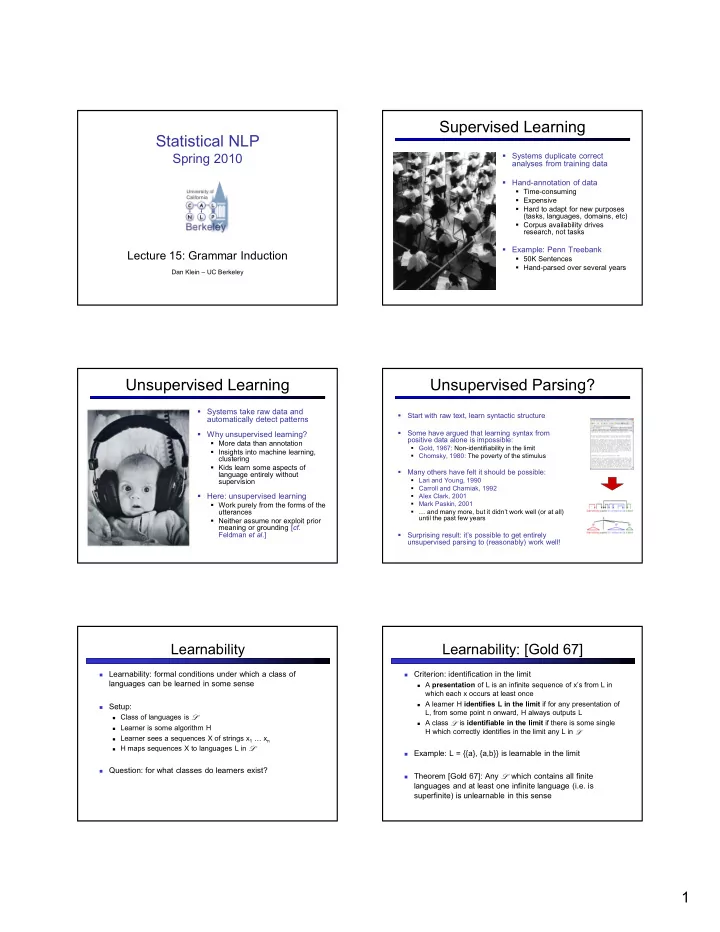

Supervised�Learning Statistical�NLP Spring�2010 � Systems�duplicate�correct� analyses�from�training�data � Hand'annotation�of�data � Time'consuming � Expensive � Hard�to�adapt�for�new�purposes� (tasks,�languages,�domains,�etc) � Corpus�availability�drives� research,�not�tasks � Example:�Penn�Treebank Lecture�15:�Grammar�Induction � 50K�Sentences � Hand'parsed�over�several�years Dan�Klein�– UC�Berkeley Unsupervised�Learning Unsupervised�Parsing? � Systems�take�raw�data�and� � Start�with�raw�text,�learn�syntactic�structure automatically�detect�patterns � Some�have�argued�that�learning�syntax�from� � Why�unsupervised�learning? positive�data�alone�is�impossible: � More�data�than�annotation � Gold,�1967:�Non'identifiability in�the�limit � Insights�into�machine�learning,� � Chomsky,�1980:�The�poverty�of�the�stimulus clustering � Kids�learn�some�aspects�of� � Many�others�have�felt�it�should�be�possible: language�entirely�without� supervision � Lari and�Young,�1990 � Carroll�and�Charniak,�1992 � Here:�unsupervised�learning � Alex�Clark,�2001 � Work�purely�from�the�forms�of�the� � Mark�Paskin,�2001 utterances � …�and�many�more,�but�it�didn’t�work�well�(or�at�all)� until�the�past�few�years � Neither�assume�nor�exploit�prior� meaning�or�grounding�[ �� .� Feldman� ����� .] � Surprising�result:�it’s�possible�to�get�entirely� unsupervised�parsing�to�(reasonably)�work�well! Learnability Learnability:�[Gold�67] � Learnability:�formal�conditions�under�which�a�class�of� � Criterion:�identification�in�the�limit languages�can�be�learned�in�some�sense � A� ������������ of�L�is�an�infinite�sequence�of�x’s from�L�in� which�each�x�occurs�at�least�once � A�learner�H� ������������������������� if�for�any�presentation�of� � Setup: L,�from�some�point�n�onward,�H�always�outputs�L � Class�of�languages�is� � � � � � A�class� � � is� ������������������������� if�there�is�some�single� � � � Learner�is�some�algorithm�H H�which�correctly�identifies�in�the�limit�any�L�in� � � � � � Learner�sees�a�sequences�X�of�strings�x 1 …�x n � H�maps�sequences�X�to�languages�L�in� � � � � � Example:�L�=�{{a},�{a,b}}�is�learnable�in�the�limit � Question:�for�what�classes�do�learners�exist? � Theorem�[Gold�67]:�Any� ����� ����� which�contains�all�finite� ����� ����� languages�and�at�least�one�infinite�language�(i.e.�is� superfinite)�is�unlearnable in�this�sense 1
Learnability:�[Gold�67] Learnability:�[Horning�69] � Proof�sketch � Problem:�IIL�requires�that�H�succeed�on�each� presentation,�even�the�weird�ones � Assume� ��� ��� is�superfinite ��� ��� � There�exists�a�chain�L 1 ⊂ L 2 ⊂ …�L ∞ � Another�criterion:� �������������������������� � Take�any�learner�H�assumed�to�identify� � � � � � Assume�a�distribution�P L (x)�for�each�L � Construct�the�following�misleading�sequence � Assume�P L (x)�puts�non'zero�mass�on�all�and�only�x�in�L � Present�strings�from�L 1 until�it�outputs�L 1 � Assume�infinite�presentation�X�drawn�i.i.d.�from�P L (x) � Present�strings�from�L 2 until�it�outputs�L 2 � H�measure'one�identifies�L�if�probability�of�drawing�an�X� from�which�H�identifies�L�is�1 � … � This�is�a�presentation�of�L ∞ ,�but�H�won’t�identify�L ∞ � [Horning�69]:�PCFGs�can�be�identified�in�this�sense � Note:�there�can�be�misleading�sequences,�they�just�have�to� be�(infinitely)�unlikely Learnability:�[Horning�69] Learnability Proof�sketch � Gold’s�result�says�little�about�real�learners� � Assume� ��� ��� is�a�recursively�enumerable�set�of�recursive�languages�(e.g.�the� (requirements�of�IIL�are�way�too�strong) � ��� ��� set�of�PCFGs) Assume�an�ordering�on�all�strings�x 1 <�x 2 <�… � Define:�two�sequences�A�and�B� ��������������� if�for�all�x�<�x n ,�x�in�A� ⇔ x� � � Horning’s�algorithm�is�completely�impractical�(needs� in�B astronomical�amounts�of�data) Define�the� ��������� E(L,n,m): � All�sequences�such�that�the�first�m�elements�do�not�agree�with�L�through�n � These�are�the�sequences�which�contain�early�strings�outside�of�L�(can’t�happen)� � or�fail�to�contain�all�the�early�strings�in�L�(happens�less�as�m�increases) � Even�measure'one�identification�doesn’t�say�anything� Claim:�P(E(L,n,m))�goes�to�0�as�m�goes�to�∞ � about�tree�structures�(or�even�density�over�strings) Let�d L (n)�be�the�smallest�m�such�that�P(E)�<�2 'n � Let�d(n)�be�the�largest�d L (n)�in�first�n�languages � Only�talks�about�learning�grammatical�sets � Learner:�after�d(n)�pick�first�L�that�agrees�with�evidence�through�n � � Strong�generative�vs weak�generative�capacity Can�only�fail�for�sequence�X�if�X�keeps�showing�up�in�E(L,n,d(n)),�which� � happens�infinitely�often�with�probability�zero�(we�skipped�some�details) Unsupervised�Tagging? EM�for�HMMs:�Process � Alternate�between�recomputing�distributions�over�hidden�variables� (the�tags)�and�reestimating�parameters � AKA�part'of'speech�induction � Crucial�step:�we�want�to�tally�up�how�many�(fractional)�counts�of� each�kind�of�transition�and�emission�we�have�under�current�params: � Task: � Raw�sentences�in � Tagged�sentences�out � Obvious�thing�to�do: � Start�with�a�(mostly)�uniform�HMM � Same�quantities�we�needed�to�train�a�CRF! � Run�EM � Inspect�results 2
Merialdo:�Setup Merialdo:�Results � Some�(discouraging)�experiments�[Merialdo 94] � Setup: � You�know�the�set�of�allowable�tags�for�each�word � Learn�a�supervised�model�on�k�training�sentences � Learn�P(w|t)�on�these�examples � Learn�P(t|t '1 ,t '2 )�on�these�examples � On�n�>�k�sentences,�re'estimate�with�EM � Note:�we�know�allowed�tags�but�not�frequencies Distributional�Clustering Distributional�Clustering � Three�main�variants�on�the�same�idea: ♦ ��������������������������������������������� ♦ � Pairwise�similarities�and�heuristic�clustering � E.g.�[Finch�and�Chater�92] � Produces�dendrograms ��������� ��������� ��������� � Vector�space�methods ��������� ����������� �������� � E.g.�[Shuetze�93] ��� �������� ��������� � Models�of�ambiguity � �������� ���������������� � Probabilistic�methods ���� ���� ����������� ♦ � Various�formulations,�e.g.�[Lee�and�Pereira�99] �������� ���� ����������������� ����������� ♦ �������� ����������������� ����������� ���������������� Nearest�Neighbors Dendrograms�����������������������_ 3
Recommend
More recommend